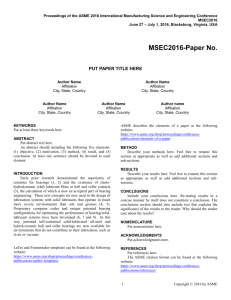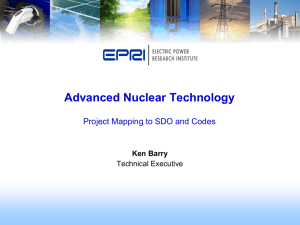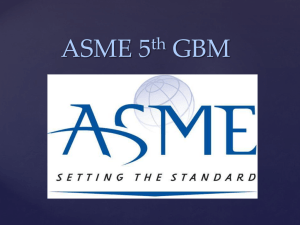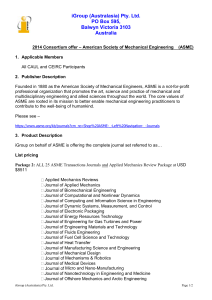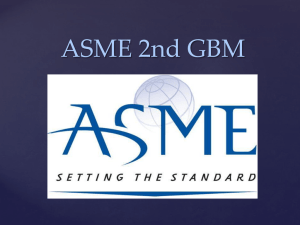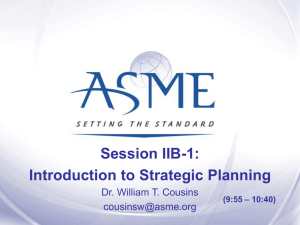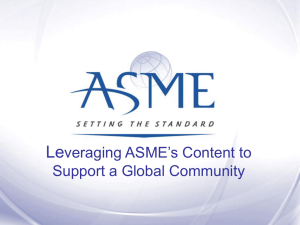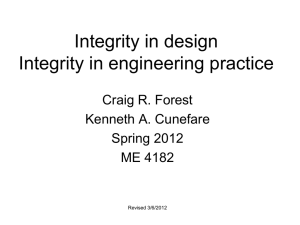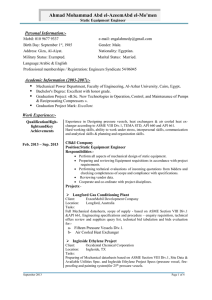ASME Liaison Report (5-18-11)
advertisement
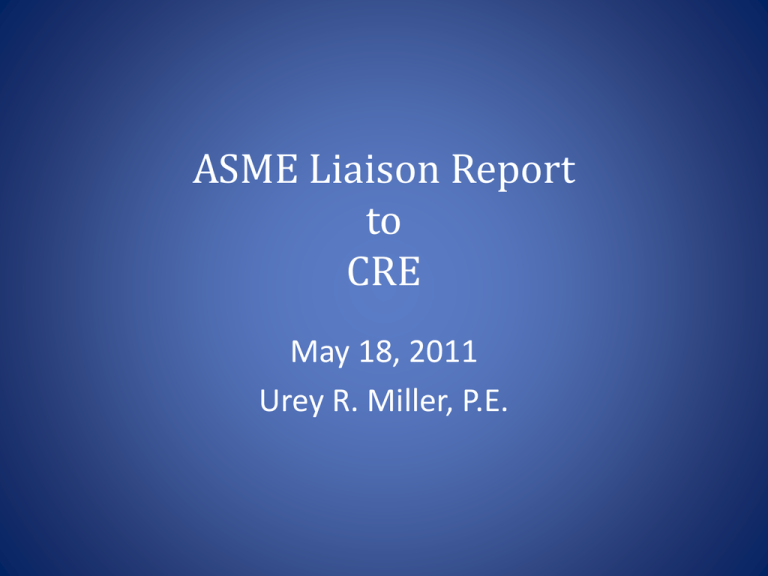
ASME Liaison Report to CRE May 18, 2011 Urey R. Miller, P.E. Post Construction Committee Committee is debating certification program for bolted joint assemblers “The purpose of qualifying flanged joint assemblers is to ensure that they are sufficiently familiar with the specified tools, joint assembly procedures, and bolt size ranges such that they consistently achieve the specified Target Prestress within the specified tolerance for the tools and assembly procedure that are to be used.” Post Construction Committee “Assemblers should be qualified by instruction and examination by a competent instructor for each joint assembly procedure and bolt size range to be employed.” ASME will certify instructor organizations who will in turn certify assemblers ASME staff will prepare and implement program in the future. ASME Boiler and Pressure Vessel Committee • ASME Code Publication cycle has been revised • The 2011 Addenda will be a full reprint of the Code (not just the revised pages) • There will be no addenda published in the future • The next Edition of the Codes will be published in 2013 • Subsequent editions will be on a two year cycle ASME Boiler and Pressure Vessel Committee Section VIII Div 1 • ASME Stamp is replaced by ASME Mark with designator for appropriate section of ASME Code • Change made for copyright reasons • Code Case will allow 18 month transition period for phase out of name plates Example of New ASME Mark UT in Lieu of RT • Paragraph UW-51 revised to incorporate Code Case 2235 which allows UT in lieu of RT • Will allow UT for material ½ inch and thicker instead of full RT • Incorporated into Div 1 by reference to Div 2 which already had UT provisions • Allows Manufacturer to apply UT without Code Case • Especially advantageous for thick refinery equipment UT in Lieu of RT (cont’d) UW-51 RADIOGRAPHIC EXAMINATION OF WELDED JOINTS (a) All welded joints to be radiographed shall be examined in accordance with Article 2 of Section V except as specified below. (1) A complete set of radiographs…… (2) A written radiographic…… (3) The requirements of T-274.2……. (4) As an alternative to radiographic examination requirements above, all welds in material 1/2 in. (13mm) and greater in thickness may be examined using the ultrasonic (UT) method per the requirements of paragraph 7.5.5 of Section VIII, Division 2. Common Rules • ASME wishes to minimize same technical requirements in three different books • Upkeep and maintenance takes more resources • Rules get “out-of-sync” with one another • Task Team will study alternatives for future Common Rules (cont’d) • Revision to UW-51 represents one “common rule” approach • A Code Case is near approval that will allow Section VIII Div 2 design rules to be used in lieu of Division 1 (using Div 1 allowable stress) • Significant Advantages of using Div 2: – Formed heads – Opening Reinforcement – External pressure (incorporates CC 2286) Electric Immersion Heater Support Plates • New mandatory Appendix 41 for the design of electric immersion support plates in lieu of UG-39 reinforcement rules • Based on the principles of Part UHX for U-tube heat exchangers • Results in significant thickness reduction of support plates Plate and Frame Task Group • ASME BPV VIII has endorsed formation of Plate and Frame Heat Exchanger Task Group • Will consider Code rules that are specific for the Code construction of plate and frame heat exchangers • Requested and will be supported by the plate and frame exchanger Manufacturers Cr-Mo Code Case –Div 1 • Committee approved a Code Case for determining allowable axial compressive stress from 700F to 1000F for 2 ¼ Cr- 1 Mo material • Based on time dependent properties • Current rules allow up to 900F • Methodology to be applied to other materials and temperatures Work Group on Design by Analysis • Responsible for Part 5 of Section VIII Div 2 (Design by Analysis) • Stress analysis, fatigue, elevated temperature • Work Group formed and have had initial meeting • Chaired by Ben Hantz (will maintain synergy with API 579/ASME FFS-1) Consideration of Weld Peaking – Section VIII Div 2 • Division 2 has been revised to require design consideration of weld joint peaking when the vessel operates in the creep regime • Div 2 already requires consideration of peaking when fatigue analysis is required • Revisions will be made that will also require design consideration of joint alignment when fatigue analysis is required or the vessel is operated in the creep regime The End Questions?

